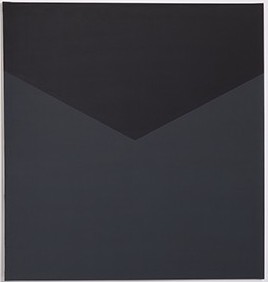
Strike 2, 1987, Acrylic on canvas, 210 cm x 200 cm
Olivier Mosset, born in 1944 in Berne (Switzerland)
|
Olivier Mosset, born in 1944 in Berne (Switzerland). Lives and works in Tucson in the United States. Olivier Mosset started his Art studies in Lausanne before becoming the assistant of Jean Tinguely and Daniel Spoerri. He lived and worked in Paris from 1965 to 1977, then settled in New York. In 1966-1967, Olivier Mosset participated in the training of the B.M.P.T with Daniel Buren, Michel Parmentier and Niele Toroni. The goal of these young artists was to demystify the artist’s personality and achieve the zero degrees of painting. As part of exhibitions organised by the group, each artist was limited to painting a single pattern, while sometimes playing around in painting the patterns of others. Olivier Mosset chose to paint a simple black ring of 15.5cm in diameter and 3.25cm thickness in the middle of a blank canvas of 100cm x 100cm. In 1977, Olivier Mosset settled in New York and founded with Marcia Hafif the Radical Painting group, active from 1979 to 1984. He began a series of monochrome canvases: paint was considered from then on as being the focus. Spread out over the canvas, the colour only shows its own presence, without gestural power or reference value. The canvases are each painted in a single colour which evenly covers their surface. All of the canvases other variables (dimensions, format, tone) vary from one canvas to the other. This monochrome era (1976-1985) was followed by that of “built abstract paintings” (1985-1993) where geometric features punctuate or divide the canvas. From 1993, Mosset produced shaped canvases (canvases that are most often non-rectangular, round or triangular, but which can have far more unique shapes) to return to single-colour paintings. In the 1980s, Mosset also moved closer to the Neo Geo movement which allowed him to deepen his understanding of the challenges of painting, the processes of Duchamp and of Warhol, and of the complex relationship between the artistic action and the image. With Olivier Mosset, painting fundamentally consists of applying colour and arranging shapes onto a surface. Accordingly, the work by Olivier Mosset can be soon as a perfect sketch of the manifesto of concrete art. From this manipulation of plastic components, Olivier Mosset exhibits an extremely coherent work around the issues of authorship, appropriation and repetition.
Crédit photo:
|